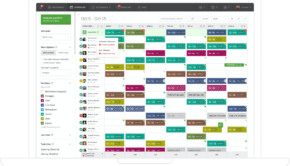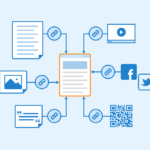The Applications for Templates Builders and Software Architecture behind them
The world is speeding up and sometimes getting extra independence in decision making can bring extra agility to an employee and the company in which he works. This is when template builders come in handy, allowing workers to handle “techie” tasks without involvement of developers.
Examples of Template Builder and their Application
Site Builder / Landing Page Generator
This is by now one of the most web developed niches on the market, so like App Makers. There are many free builders as well as paid services that provide a comprehensive set of features, including hosting, payment gateway, and other e-commerce tools you ma need.
The most notable are:
- WIX
- Shopify
- Squarespace
- CoffeeCup Software
For corporate needs one may require only a simple landing page generator, that will allow creating custom one-page websites for marketing activities without the need to involve software developers.
The functionality of LPgenerator:
- Constructor-like architecture (drag-and-drop mechanics).
- Customizable building blocks (buttons, background, text fields, rule & space elements).
- Media elements support (embeddable video player, images support, audio file support).
- Visualizations and motion element support (you can add additional library or JavaScript with an effect you want to add to the page).
- Automated SEO, performance optimization (meta tags generator, img optimization, etc)
The list of element and functions to add can be gradually expanded, as long as they will be placed in a separate backend modules. The important thing to note here is to develop a separate template list in backend architecture, which could be used for saving of users preferences and separating different users from each other.
Email Builder
The email builders look pretty much the same as LP generators. The only difference here is the number of constraints regarding content formats that could be used in email. Generally, these builders are used by newsletter services such as MailChimp and UniSender, in order to provide additional value to users.
Frankly speaking, there is no sense for the development of standalone builder. The only reason is to make a complete ecosystem, which would allow all company members use the same set of templates without leaving the app.
Integration of Email Service
The alternative to development from scratch is to integrate a ready-made solution. This why you can take advantage of all advanced feature available on the market. The first and foremost one is comprehensive statistics the most email services provide to their client.
Statistics provided by email services:
- Open/click tracking.
- Heat map.
- Delivery rate by an email client.
- Analytics by age, geography, specific audience.
- A/B testing statistics.
Things to consider:
- Only a few big email service (like MailChimp) provide API and remote interface that you can add to your corporate web system.
- Be prepared to take care of all data visualizations and designs your app acquires from email service.
- Make a full list of data you wish to get from the email service in advance, as long as it takes additional development time to add another parameter.
CV Builders
Great tools for job portals that increase conversions and get new users. It must be acknowledged that by making a customizable, responsive CV builder the job board can attract new acquaintances and standardize the data processing.
The advantages of CV builders:
- Streamline the registration process.
- Get an easy structured, standardized data, that could be automatically processed without human input.
- Provide companies with additional tools and filters to perform a search of prospects.
Along with our work GBKSOFT have integrated CV builder into two job board portals: Resume Lift and Werk in Africa. Each of them has experienced a boost in the number of new CVs added as well as the number of request from employers.
Project Management Tools
Among most notable PM tools are Trello, Jira, and Basecamp. Although they do not use templating functionality, they basically utilize the same software architectural principles: drag-and-drop feature, standardized building blocks, text fields, media embedding.
Customer Journey Builders
This is perhaps the apex of all previously covered builder. The comprehensive multi-purpose advertising system that can follow the customer through all digital communication channels.
There are few Journey Builders worth mentioning:
- Spark Page made by GBKSOFT.
- Sitefinity made by Progress.
By using those systems digital marketers can create and serve various content to the customer and generate more conversions and purchases. For instance, Spark Page itself is an elegant and intuitive platform which allows users to create engaging customer journeys.
To make this happen journey builder should carry in itself several modules as email builder, landing page generator, and journey management system like PM tool.
Features to include in Journey Builder:
- Number of steps completed.
- Conversion rate for each step/campaign.
- Time required for each step.
- Current position of user on journey map.
Template Builder Architecture Advice
Any common template building system, as well as any other app or website, consists of two main parts. Front End – which is displayed to a user – and Back End – where all the work is performed with Data Base beside it.
Front End / User View
Consists from HTML/CSS/Images/Input Forms – This is all those elements responsible for builder appearance. They describe Design, Layout, and Style of building blocks.
JavaScript Framework.
For instance, Angular.js or React.js frameworks – Those techs describe logic, location, interaction zones, interaction methods that are used to tweak and change building blocks. For instance, mousedown (take element), mousemove (move element), mouseup (drop element) actions are all described by JavaScript.
API as a Mediator
We advise using API in order to connect Front & Back end of the builder. The API will allow us to separate different functions and make two parts automated, thus ensuring their stability.
Here’s example of functions that will be handled through API:
- Saves builder state.
- Loads builder state.
- Loads lists of templates.
- Loads previously saved content.
- Uploads content.
In order to unify different Builders (email, landing page, CV) we can wrap up and put several blocks into separate modules.
- One API for all Builders.
- One JavaScript module for all common logic and user interactions.
In addition, it is highly recommended to apply versioning principle to those modules which will make the system flexible and responsive to further changes. For instance, you can make additional сhanges and improvements in Landing Page Builder, then create a new version of this module, while letting all other building blocks to continue using the older version.
While those modules could be used in all Builders, we should dedicate separate Databases for each one. This way we’ll increase system stability, optimize load balancing and ensure flawless scaling of builders if needed.
Bottom Line
It must be acknowledged that development of such system is a complex and demanding process. Which is why small and medium business is not likely to need on of such integrated tools. They may use few separate tools without losing their mobility.
Nevertheless, Template Builders are powerful tools, that can speed up workaround of the marketing department and even several departments inside a big enterprise. Given that with the increase in size company’s mobility usually falls, the template builder becomes an irreplaceable tool in pursuit of agility.








![10 Ways to Tighten Security on a Public WiFi [Infographic]](https://technofaq.org/wp-content/uploads/2017/05/tbvpn-public-wifi-guide-150x150.png)






